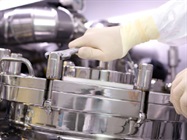
Set up, maintenance, and cleaning of traditional bioreactor vessels and related equipment is costly and time-consuming. Single use technology is employed by pharmaceutical biomanufacturing in upstream and downstream processing and it allows for more flexibility. Although “single use” typically brings to mind a smaller scale of operation, single use technology is implemented in bioreactors with volumetric capacity spanning from a few liters to thousands of liters of reaction product. The growing adaptation of single use technology also streamlines the transportation process, as single use systems and bags are composed of advanced polymers and are lighter than traditional systems. Bioprocess bags can be used to store reagents and media suspensions. Single use technology can provide greater peace of mind by reducing potential contamination and ensuring a reaction is not damaged by extensive holding times as might be encountered in a traditional steel bioreactor system.
Primary
Applications of Single Use Bioprocess Equipment
- As a culture media and buffer preparation vessel for
bioprocessing
- Drug product transport
-
Sterile filling
-
Disposable freezing
Configurations
and Purchasing Considerations for Single Use Equipment
Configuring a full scale single use bioprocess operation for your pharmaceutical manufacturing protocol involves research and insight into the scale of the desired reaction output. Individual process components can be purchased pre-sterilized to maximize sterility protocol during reactions. New methods and equipment for single use bioprocessing are being actively developed. Expiries on patents of biosimilars provide significant encouragement for the development and use of reliable single use systems in the pharmaceutical manufacturing protocol. Special purchasing considerations include working around existing equipment, developing a new equipment plan, and negotiating costs of initial set up and the anticipated, ongoing costs of buying disposable components for a process or system. Industry experts promote single use technology for its ultimate reduction in capital costs, reduction of floor space used, and a reduction in cost of goods. Implementation of a grounds-up single-use system may provide significant cost savings for longer-term manufacturing runs in the form of higher production recovery, higher reaction quality, ease of set up and use, better reaction monitoring, reduced cleaning steps, and the convenience of disposal.
Follow Us
Keep up with our latest articles, news and events. Plus, get special offers and
more delivered to your inbox.